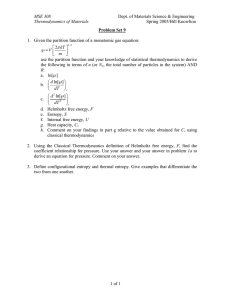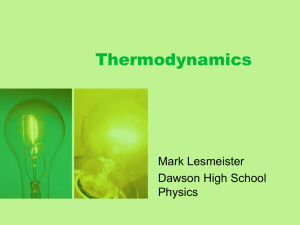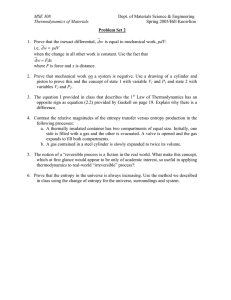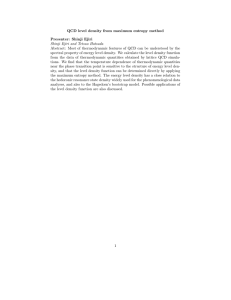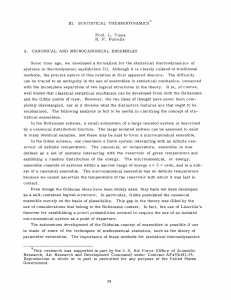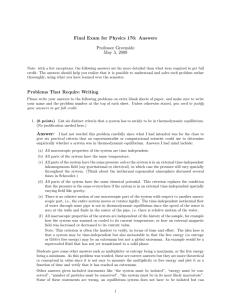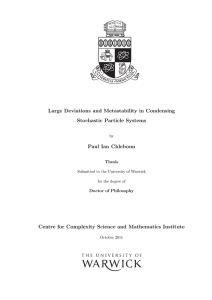Prof. L. Tisza P. M. QuayT
advertisement
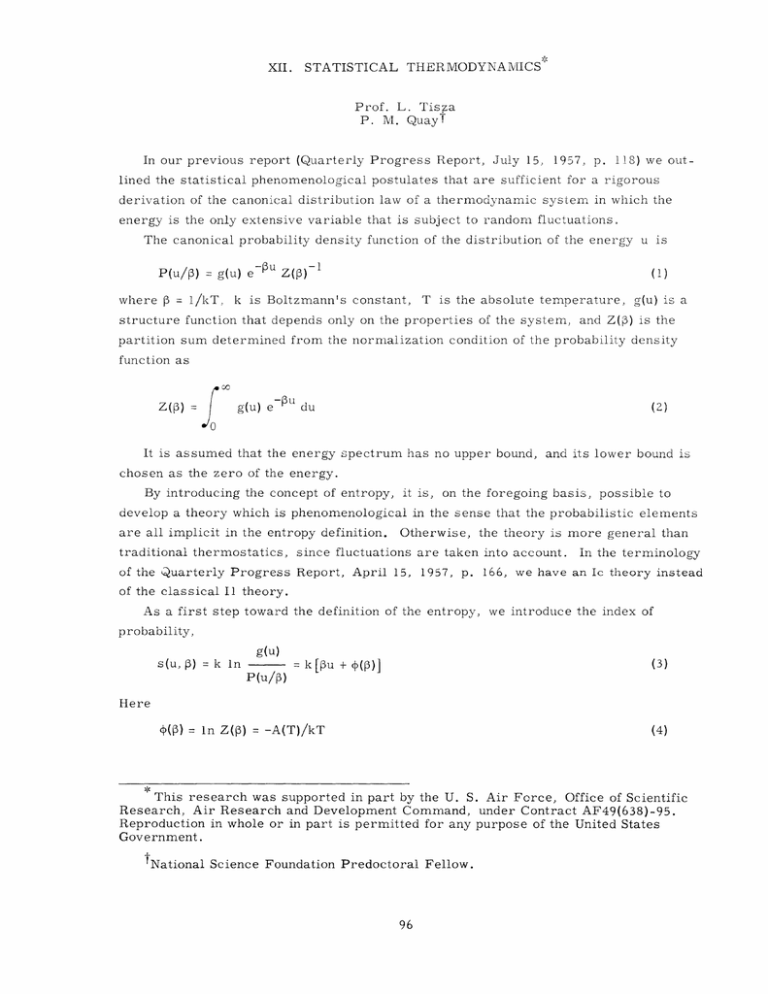
XII. STATISTICAL THERMODYNAMICS' Prof. L. Tisza P. M. QuayT In our previous report (Quarterly Progress Report, July 15, 1957, p. 118) we out- lined the statistical phenomenological postulates that are sufficient for a rigorous derivation of the canonical distribution law of a thermodynamic system in which the energy is the only extensive variable that is subject to random fluctuations. The canonical probability density function of the distribution of the energy u is P(u/p) = g(u) e-pu Z(p) - 1 where (1) p = 1/kT, k is Boltzmann's constant, T is the absolute temperature, g(u) is a structure function that depends only on the properties of the system, and Z(P) is the partition sum determined from the normalization condition of the probability density function as cc Z(p) = (2) g(u) e-u du It is assumed that the energy spectrum has no upper bound, and its lower bound is chosen as the zero of the energy. By introducing the concept of entropy, it is, on the foregoing basis, possible to develop a theory which is phenomenological in the sense that the probabilistic elements are all implicit in the entropy definition. Otherwise, the theory is more general than traditional thermostatics, since fluctuations are taken into account. of the Quarterly Progress Report, April 15, In the terminology 1957, p. 166, we have an Ic theory instead of the classical Il theory. As a first step toward the definition of the entropy, we introduce the index of probability, s(u, p) = k In g(u) = k [pu + P(u/p) (p)] (3) Here c( ) = In Z(P) = -A(T)/kT (4) This research was supported in part by the U. S. Air Force, Office of Scientific Research, Air Research and Development Command, under Contract AF49(638)-95. Reproduction in whole or in part is permitted for any purpose of the United States Government. -National Science Foundation Predoctoral Fellow. (XII. is the Mathieu function, STATISTICAL THERMODYNAMICS) and A(T) is the Helmholtz free energy. Since the energy u is a random variable, the same is true of s(u, P). In order to define the thermodynamic phenomenological entropy, we have to distinguish two cases: (i) (ii) the system is in contact with a reservoir of temperature T, hence p is constant. the system is isolated and has a fixed energy u. These two cases correspond to the canonical and microcanonical ensembles of statistical mechanics. The discussion of the first case closely parallels the traditional method, and we shall confine ourselves to a short summary of the relevant formulas. The discussion of case ii has entirely novel features. In case i the entropy is defined as the average of the random variable (see Eq. 3), S(p) = s(u, P) = kpu + k O(P) (5) f" g(u) du P(u/P) In P(u/p) The thermodynamic properties of the system are contained in the fundamental equation (P) = (6) S(p) - pU = -A(T)/kT where (7) U =u = - ap The energy fluctuation is Au2 ap2 (8) > 0 We turn now to case ii. The procedure most frequently applied is to define the entropy for an isolated system as S = k In g(u) (9) The proper definition of the temperature is somewhat problematic in this case (1). Following a suggestion of Mandelbrot (2), we have assigned a temperature to isolated systems by using the maximum likelihood method of mathematical statistics (3). We found that in the present context the use of this method can be made plausible on the grounds of simple physical considerations. Let us assume that before its isolation the system reached its state of energy uo through contact with a reservoir of temperature T = i/kp. In classical thermostatics, (XII. STATISTICAL THERMODYNAMICS) an Ii theory, there is a unique functional relation between uo and P. This is not true in the Ic theory, in which the energy is allowed to fluctuate within a canonical distriHowever, bution. it is still possible to estimate the temperature. Following the method of maximum likelihood estimation, bility density function (1), its dependence on a In P(u IP) or more conveniently its logarithm, should be maximum in Hence 8 -- u =0 (10) a3 P ap2 P. we require that the proba- (11) <0 if Po is the solution of Eq. 10. If we compare Eq. 7 with Eq. the canonical average is i= u . ations are altogether neglected. temperature from Eq. 10, we see that 1/k is that temperature for which This is consistent with the I1 theory, in which fluctu- However, in the present case the determination of the 10 is not sharp. Expanding In P(uI P) as a function of p around Po, and breaking off at the quadratic terms, we find that the estimated reciprocal temperatures have a standard deviation Ap that obeys the relation Au ap = k (12) where Au is the standard deviation (rms fluctuation) of the energy in the canonical distribution of the temperature 1/kp o This relation has an interesting physical meaning. The transition from the present Ic theory to the Il theory corresponds to a limiting process: k-0, Au -0, A - 0 (13) In the Ii theory there is no difference between an isolated system of energy uo and a system that, is in contact with a reservoir, provided that u0 = and p = 1/kT have sharp values, i. e., i. Moreover, both u the energy of a system uniquely determines the temperature of the surroundings with which it might be in equilibrium, and, conversly, the temperature of a reservoir uniquely determines the energy of the system with which it is in contact. The approximate validity of Eq. 13 assures us that the Il theory is approximately correct. However, large values of Au or Ap are indications that in singular situations the phenomenological theory is close to the limits of its usefulness. At a critical point, the energy fluctuations are very great (Nu - oo), energy is not precisely determined by the reservoir temperature. absolute zero exhibits the opposite features: Au -0, A3 -oo. hence the The singularity at Physically, this means (XII. STATISTICAL THERMODYNAMICS) that with such low temperatures that the specifice heat very nearly vanishes, the knowledge of the energy of the system does not enable us to draw any reliable inferences about the temperature of the surroundings. This means, in simple terms, that a sub- stance with nearly vanishing specific heat is not an appropriate thermometric substance, which is well known to low-temperature physicists. While the Ic theory is a great improvement over the Il theory, as far as describing the aforementioned singular situations is concerned, the difficulties connected with these situations have not all been removed and call for further analysis. L. Tisza, P. M. Quay References 1. A. I. Khinchin, Statistical Mechanics (Dover Publications, p. 142. 2. B. Mandelbrot, Massachusetts, (Sept. 1956). 3. Cf. B. L. Van der Waerden, p. 148. Inc., New York, 1949), 1956 Symposium on Information Theory, held at M.I. T., Cambridge, Sept. 10-12, 1956; Trans. IRE, vol. IT-Z, no. 3, pp. 190-203 Mathematische Statistik (Springer Verlag, Berlin, 1957),

